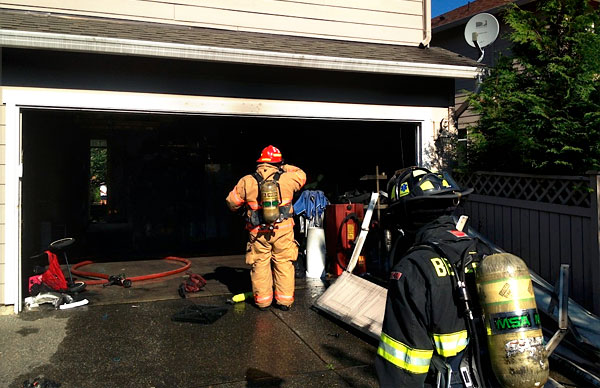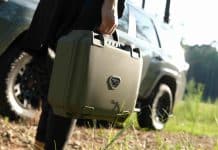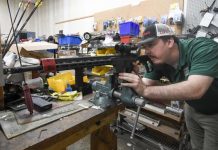
Not every “bug out” scenario your family may face will start with a natural disaster or civil unrest. Preparing for those scenarios, however, will ensure you and your family have a smooth and efficient transition out of your home, whatever the situation, when the moment comes.
As I pull into the office my phone rings and it’s our nanny. I answer, and the first words out of her mouth are “everyone is ok, but you need to come home!” She continues with words including “fire” and “explosion” and “f**k!”
Last week, my family suffered a house fire (everyone is ok).
While setting a new land-speed record as I retraced my tracks down the freeways I’d just been on a few minutes prior, I called my wife and, as calmly as I could, asked her to start heading home too. Meanwhile, two fire engines, a ladder truck, a paramedic unit, a battalion chief, two police officers and a sergeant had all responded to my home. The firefighters were handling the fire and the police were tending to my family. I’ll do a separate post on how and why we selected our suburban neighborhood but, for now, know that this is a “typical response” from our police and fire departments. Our firefighters were in-the-house, getting to work, within about 6 minutes of my nanny’s 911 call… Amazing!
“Our firefighters were in-the-house, getting to work, within about 6 minutes of my nanny’s 911 call… Amazing!”
I eventually arrived at the house, found and hugged my little ones, and spoke with the fire department and the police. A few short hours later it was time to depart because our house was not safe for us to stay in. Obviously this was not a SHTF situation, nor a natural disaster, but our preparations for those kind of events ensured we were over-prepared to expeditiously do what needed to be done in this one. We already knew how to get what we needed, load it, and leave in a hurry with it.

Now, 10 days after the fire, I am sitting in a hotel room with my family writing this column. We can move back into the house in 4-6 months.
Whether it’s the apocalypse, or just a simple house fire, the ability to “bug out” quickly, efficiently and thoroughly is an important advantage that can be made easy with a little planning. I could write for days on various “bug out” processes, considerations, and location requirements… and there are countless resources online discussing the contents of a proper “bug out” kit and the strategies for building it. In this post, however, we’re going to discuss how you actually get out of the house and why having a “bug out” checklist is helpful.
Wait for it… ok, now! You have 5 minutes to get your family out of your house. What are you taking, where are the kids, what are you going to do with your kids while you grab your things? What vehicle are you taking? How much fuel does that vehicle actually have at this very moment? Do you fill your tanks when they’re near-empty or when they reach half-full? What food and water are you taking? What about clothing, shelter, first aid and medicine? With kids, what about comfort items like teddy bears, toys, “sippy cups,” pacifiers, and their favorite blankets? What about weapons, ammunition, and the ability to secure them? Do you have all these things in containers that will withstand fire and/or building collapse, and are they in places you can access them if that were to happen? What technology items are you taking and how will you charge them? Where are you going and what route(s) can you take to get there? The questions go on and on…
The answers to any one of these questions could, and probably will at some point, be the subject of an entire Tactical Parent column. But, for this post, I’m going to focus on the importance of having a checklist.
“Remember, it may not be you that’s doing the bugging out so make your process and list as clear as possible to ensure that someone without the same mindset as you can still be successful.”
When creating your checklist, you can spend the time it takes to think out all the things you will need and want to bring with you. Creating the checklist ahead of the “go signal” gives you the time to work through what items are higher priority than others based upon your individual situation. In short, if you only have 7 minutes to get out, and your checklist takes 10 minutes to complete, you can ensure you get the most important stuff first, and leave the lower-priority items to be loaded last. If you have more than one person capable of helping you grab stuff, you should designate their “duties” ahead of time so that everyone knows exactly what they are to do and in what order. You should also designate the order-of-operations should it become a one-person task. Remember, it may not be you that’s doing the bugging out so make your process and list as clear as possible to ensure that someone without the same mindset as you can still be successful.
So, for example, in the first minute or two my wife and I will get the kids strapped into their car seats, grab important documents, cash, medicine, food, water, and weapons. These items are already grouped and set-up to be grabbed in-bulk and taken easily. For example, we keep all the medications in a plastic storage bin in a drawer. As the minutes pass, we begin throwing all the clothing we have into large rolling duffle bags and we start grabbing things like camping gear and tools. Eventually we start loading “comfort gear” like new toys for the kids (which we’ve had stashed for this exact situation) and eventually, time permitting, we make our way down the list to our lowest priority items like our favorite adult beverages (also already set-aside for this situation). At a point, the moment comes when it’s time to leave… and, when it’s that time, we’ll depart knowing we have as much of the important stuff as the time we had would allow.
The key, again, is preparation. Create your “bugging out” checklist based upon your specific and unique needs. Practice it with your family at least once each year. Should you arrive at the moment of need, you’ll be glad you have it and have practiced it.
Returning to the aftermath of my fire, it’s now time to leave. Realizing that part of our house is burnt up and the other is covered with a healthy layer of toxic smoke and soot, we reached for one of the copies of our “bugging out” plan (keep copies of it in several places). We started by loading the kids in the car and then began going down the list, item by item. Now, thanks to our plan, I’m sitting in the hotel room writing this column with the knowledge that we brought everything we needed with us (that wasn’t damaged by the fire). A lockbox with firearms is on the desk next to me, we have plenty of cash should we need it, and soon I’ll join my son as he builds a few sets of Legos and play with my daughter as she dresses her new doll in pajamas… brand new toys they never knew we had until we arrived at the hotel.
So, think about your family’s specific needs. Determine where those needs fall on a priority continuum relative to one another. Create your prioritized “bug out” checklist, save multiple hard-copies of it in various places, and practice executing it with your family at least once annually. Always keep your fuel tanks at least half-full and don’t skimp on the “comfort gear” if time permits.
Lastly, and as a side note, take pictures and video of all your spaces now. Seriously, trust me – do it now. As you do that, complete an inventory of the contents and check your insurance coverages to ensure they’re more than enough to cover everything you could lose. Back-up all of your important photos and videos on hard drives and in the cloud… and then store those hard drives and important documents in your safe along with your cash and a copy of your “bug out” plan. When “life happens,” you’ll be glad you did.













Doug that was a great article and eye opening for me and my family. I hope you and your family are coping with your loss of house and property and can get back to your family life as normal. You have a lot of good ideas that I have overlooked, like taking pictures of our house to show the condition before a trajedy. Also having toys and activities for my children. I especially like breaking down the list into the most important things to grab first and go down the line from there. Would you be able to post your checklist to give me a starting point for a list.
Comments are closed.